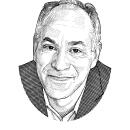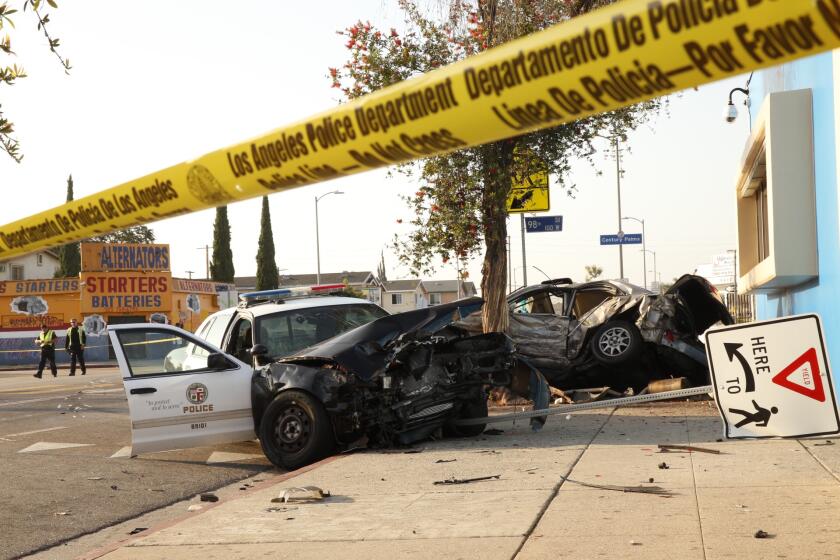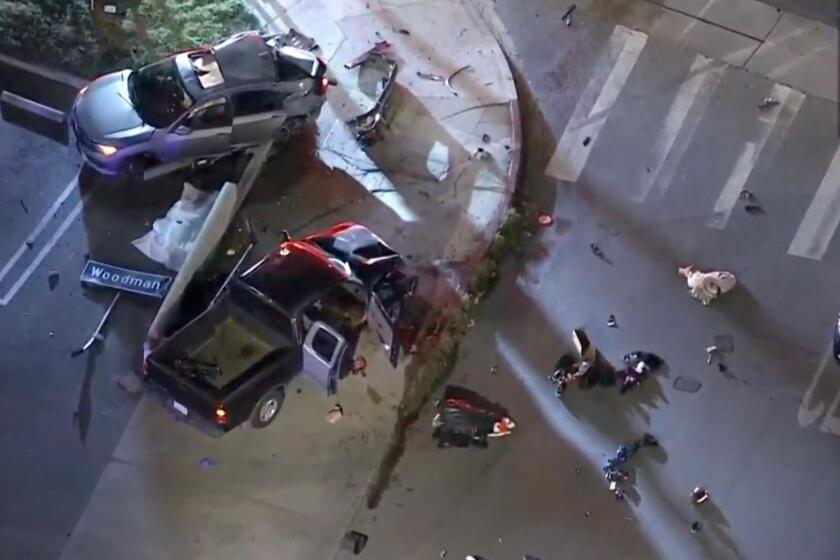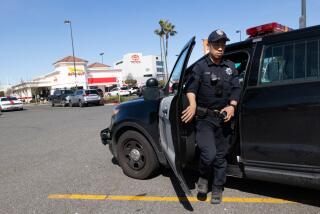Column: High-speed, high-adrenaline car chases are an L.A. staple. But are they worth the risks?
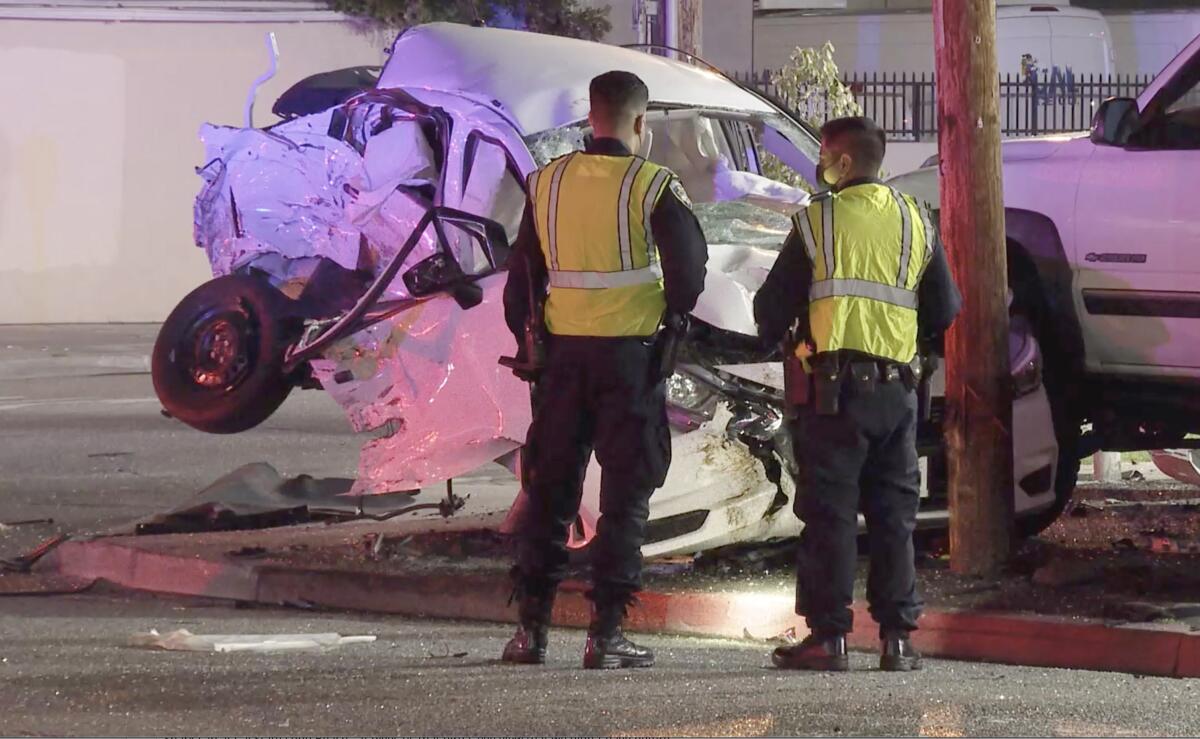
- Share via
On Jan. 31 at about 7:30 p.m., police received a call about a stolen Toyota truck. They quickly located it, but as they approached, the driver gunned the engine and fled, and a pursuit began through the San Fernando Valley.
The Los Angeles Police Department officers chased the pickup at speeds of up to 79 mph. But just a few minutes after it began, the chase came to an end at Woodman Avenue and Lanark Street in Panorama City, with the thunderous bang of a collision, a street sign knocked to the ground, detritus scattered across the road — and two entirely innocent men who had nothing to do with the chase dead at the scene.
They were lifelong friends, aged 47 and 49, who’d gone out for tacos. They were sitting in a parked Honda Civic minding their own business when the stolen truck, chased by police, T-boned them.
Opinion Columnist
Nicholas Goldberg
Nicholas Goldberg served 11 years as editor of the editorial page and is a former editor of the Op-Ed page and Sunday Opinion section.
Police pursuits are an old story in L.A. High-speed chases have long been part of the culture of sprawl, broad boulevards, freeways and fast cars. They’re exciting and adrenaline-fueled; they’re real-life movie scenes.
But much of the time, the outcomes are anything but entertaining. According to new figures presented to the Board of Police Commissioners at the end of April , there have been 4,203 police chases since 2018. More than 1,000 of them — 25% — have resulted in a death or injury.
Worse yet, half of the people who died or were injured were bystanders, like the two friends who went for tacos, with no connection to the pursuit.
That’s a shocking number of innocent victims — but it’s nothing new.
In 2015, James Queally reported in The Times about the dangers of police pursuits in Los Angeles, “where chases have long been part of cop lore and a staple of live local television news broadcasts.” He found, among other things, that pursuits by the LAPD injured bystanders at more than twice the rate of police chases in the rest of the California.
An LAPD report found that city officers have been involved in 4,203 pursuits since 2018, a quarter of which ended with an injury or death. Nearly half of those collisions ended with injuries to bystanders.
In the years since, there have been more news stories, internal reports, a grand jury investigation and some additional rules and training. But instead of declining, the number of pursuits, collisions and injuries have all gone pretty steadily up from 2018 to today, according to the LAPD.
As for bystanders, 78 were hurt in 2015, according to the California Highway Patrol. But the new report by the LAPD shows an average of 98 bystander injuries per year over the last five years, including 102 in 2021 and 118 in 2022.
Here are some caveats: It’s more often the fleeing suspects who end up in collisions than the police. Furthermore, deaths to bystanders are far, far less frequent than injuries: Nine “3rd parties” have been killed during pursuits since 2018. And of the injuries, the vast majority are not considered severe, which is generally defined as being admitted to the hospital.
Police also note that the increase in pursuits coincides with a rise in car thefts. In the period since 2018, 44% of pursuits were for auto theft, 17% for suspected DUIs and 11% for reckless driving.
Still, it is unacceptable that LAPD pursuits injure nearly 100 innocent bystanders annually. And while nine deaths may not sound like many, it is an utterly intolerable number if one of the dead was your child, parent, spouse, friend or sibling.
“A stolen truck isn’t worth it,” said Joellen Ammann, the sister of Chris Teagarden, one of the bystanders who died in Panorama City.
Two bystanders were killed when a pickup that had been reported stolen and had been pursued by police crashed into a parked Honda Civic in Panorama City.
Police say banning pursuits entirely would create bad incentives.
“If you know with impunity you won’t be chased, then why not run?” LAPD Deputy Chief Donald Graham said in an interview.
That’s a reasonable point. But I also doubt, just as Ammann did, whether it makes sense to go careening through town (injuring someone every fourth time out) to catch people suspected of relatively minor crimes.
“If you’re chasing a terrorist or a rapist or a murderer, that’s one thing — but not for a stolen car or a stolen TV,” said Geoffrey Alpert, a professor of criminology at the University of South Carolina who has been studying police pursuits since the 1990s. “It’s not a good return on the investment.”
Sure, sometimes the fleeing driver is a parolee with a weapon who doesn’t want to get caught and be reincarcerated. But people often flee for stupid reasons, Alpert says: They don’t want points on their license or it’s been suspended or they fear they’ve had one drink too many. They sometimes pay heavily for those bad spur-of-the-moment decisions.
How did the O.J. Simpson white Bronco chase unfold? Here is a timeline of events
The cops are often tempted to keep a chase going rather than calling it off because they’re reluctant to let a bad guy get away, and because of the adrenaline rush, Alpert says.
Alpert notes that many “progressive” cities now limit pursuits to those involving violent crimes. Police in Phoenix, Dallas and Philadelphia have stopped chasing people suspected of misdemeanors.
The LAPD has, to its credit, thought about these issues. During any pursuit, its officers are expected to undertake a balancing test to determine, among other things, “whether the seriousness of the initial violation or any subsequent violations reasonably warrants continuance of the pursuit,” according to the department manual.
Officers in pursuits are supposed to be continually evaluating whether they are putting the public at “unreasonable” risk. They consider weather and traffic conditions and the nature of the neighborhood they’re in.
And it’s not just the cops in the car deciding; there are generally supervisors monitoring the pursuit and making real-time decisions whether to continue it.
But the LAPD doesn’t restrict its chases to felonies or violent crimes.
Deputy Chief Graham said the department is currently analyzing how other cities have fared after adopting more restrictive policies. The analysis, requested by the police commission, will consider not just whether injuries and deaths went down, but also what effect the new rules had on crime.
If the data demand it, the LAPD should change its rules. Yes, there’ll be fewer car chases on TV to entertain us. But police should help avert injuries — they shouldn’t help cause them.
More to Read
A cure for the common opinion
Get thought-provoking perspectives with our weekly newsletter.
You may occasionally receive promotional content from the Los Angeles Times.
